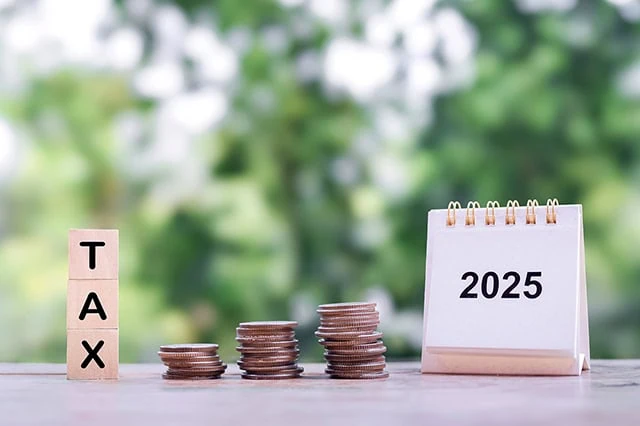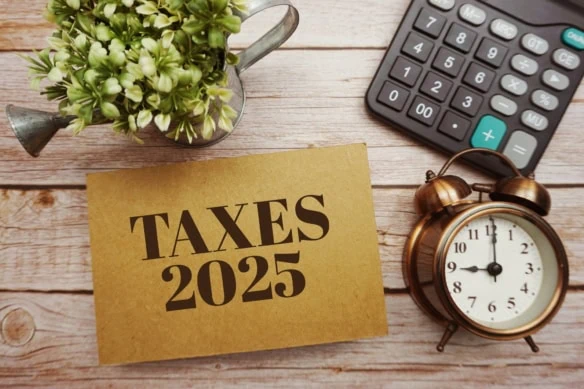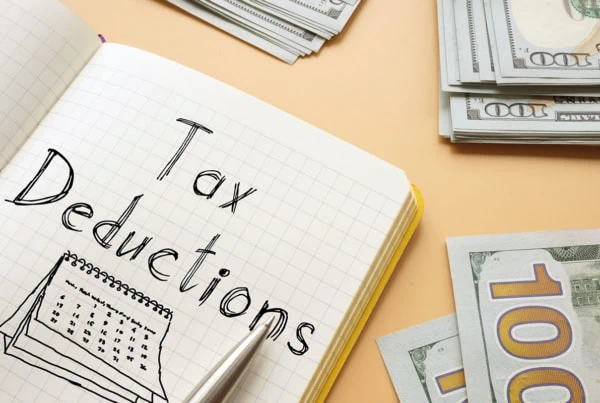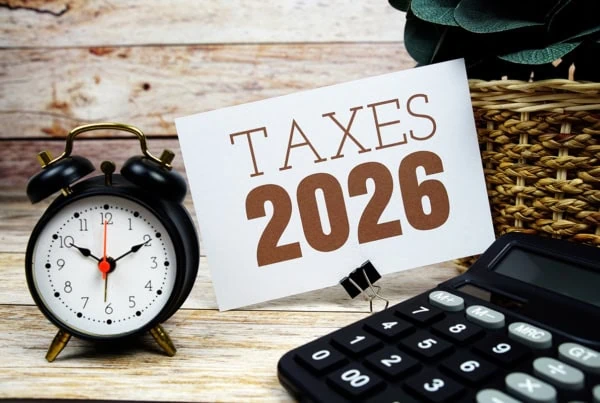Since the due date for your 2024 federal income tax return is still months away, it might seem odd to start thinking about your 2025 federal tax return now. But it’s never too early to begin preparing for the next tax year (e.g., for setting withholding, retirement plan distributions, etc.). And there’s no better place to start your advance tax planning than with the federal income tax brackets and rates for 2025.
The IRS adjusts the federal tax brackets every year account for inflation. The tax agency recently released the new brackets for the 2025 tax year, and because the inflation rate has continued to slow from its 2022 peak, the bracket adjustments were smaller for a second consecutive year.
Don’t be caught off guard when the new year finally arrives. Check out the new tax brackets now, and take the first step toward a lower tax bill for the 2025 tax year.
Related: New Standard Deduction Amounts for 2025
Featured Financial Products
Federal Income Tax Rates for 2025

The federal tax rates themselves haven’t changed for the 2025 tax year—they’re not impacted by inflation from one year to the next, but rather by tax law. So in 2025, the seven federal tax rates remain 10%, 12%, 22%, 24%, 32%, 35%, and 37%.
However, nothing stays the same forever. Most of these tax rates are scheduled to rise starting with the 2026 tax year. That’s because the federal tax rates were lowered by the Tax Cuts and Jobs Act beginning with the 2018 tax year—but the rate reduction is only temporary.
Once the temporary reduction expires, the seven federal income tax rates will be 10%, 15%, 25%, 28%, 33%, 35%, and 39.6%.
But the upcoming rate change isn’t necessarily set in stone; it could be delayed, moved up, or even repealed by 2026. However, we probably won’t have any clarity on potential changes until after the 2024 federal elections, when we know which political parties will control the White House and Congress.
Related: Capital Gains Tax Rates for 2024 + 2025
Federal Income Tax Brackets for 2025

The federal income tax brackets for 2025 are in the tables below. Which table to use depends on your likely filing status for the 2025 tax year (i.e., single, married filing separately, married filing jointly, surviving spouse, or head of household).
The tables provide the tax rate, taxable income range, and tax calculation instructions for each tax bracket. So, once you determine your expected 2025 filing status and taxable income, you can predict the tax bracket you’ll be in—and highest tax rate you’ll pay.
[For the 2024 tax brackets, see Federal Tax Brackets and Rates for 2024 + 2025.]
2025 Tax Brackets for Single Filers
| Tax Rate | Taxable Income Range | Tax Calculation |
|---|---|---|
| 10% | $0 to $11,925 | 10% of taxable income |
| 12% | $11,926 to $48,475 | $1,192.50 plus 12% of amount over $11,925 |
| 22% | $48,476 to $103,350 | $5,578.50 plus 22% of amount over $48,475 |
| 24% | $103,351 to $197,300 | $17,651 plus 24% of amount over $103,350 |
| 32% | $197,301 to $250,525 | $40,199 plus 32% of amount over $197,300 |
| 35% | $250,526 to $626,350 | $57,231 plus 35% of amount over $250,525 |
| 37% | $626,351 or more | $188,769.75 plus 37% of amount over $626,350 |
2025 Tax Brackets for Married Couples Filing Jointly and Surviving Spouses
| Tax Rate | Taxable Income Range | Tax Calculation |
|---|---|---|
| 10% | $0 to $23,850 | 10% of taxable income |
| 12% | $23,851 to $96,950 | $2,385 plus 12% of amount over $23,850 |
| 22% | $96,951 to $206,700 | $11,157 plus 22% of amount over $96,950 |
| 24% | $206,701 to $394,600 | $35,302 plus 24% of amount over $206,700 |
| 32% | $394,601 to $501,050 | $80,398 plus 32% of amount over $394,600 |
| 35% | $501,051 to $751,600 | $114,462 plus 35% of amount over $501,050 |
| 37% | $751,601 or more | $202,154.50 plus 37% of amount over $751,600 |
2025 Tax Brackets for Married Couples Filing Separately
| Tax Rate | Taxable Income Range | Tax Calculation |
|---|---|---|
| 10% | $0 to $11,925 | 10% of taxable income |
| 12% | $11,926 to $48,475 | $1,192.50 plus 12% of amount over $11,925 |
| 22% | $48,476 to $103,350 | $5,578.50 plus 22% of amount over $48,475 |
| 24% | $103,351 to $197,300 | $17,651 plus 24% of amount over $103,350 |
| 32% | $197,301 to $250,525 | $40,199 plus 32% of amount over $197,300 |
| 35% | $250,526 to $375,800 | $57,231 plus 35% of amount over $250,525 |
| 37% | $375,801 or more | $101,077.25 plus 37% of amount over $626,350 |
2025 Tax Brackets for Head-of-Household Filers
| Tax Rate | Taxable Income Range | Tax Calculation |
|---|---|---|
| 10% | $0 to $17,000 | 10% of taxable income |
| 12% | $17,001 to $64,850 | $1,700 plus 12% of amount over $11,925 |
| 22% | $64,851 to $103,350 | $7,442 plus 22% of amount over $48,475 |
| 24% | $103,351 to $197,300 | $15,912 plus 24% of amount over $103,350 |
| 32% | $197,301 to $250,500 | $38,460 plus 32% of amount over $197,300 |
| 35% | $250,501 to $626,350 | $55,484 plus 35% of amount over $250,525 |
| 37% | $626,351 or more | $187,031.50 plus 37% of amount over $626,350 |
Featured Financial Products
Related: 10 Year-End Tax Planning Tips to Lower Your Tax Bill
Inflation Adjustments for the 2025 Tax Brackets

Inflation adjustments increase both the “floor” and “ceiling” of each tax bracket. They also expand the “width” of each bracket’s taxable income range (i.e., the gap between the bracket’s lower and upper income thresholds).
For instance, the 22% tax bracket for single filers applies to $53,374 of income for the 2024 tax year (i.e., income from $47,151 to $100,525), but it applies to $54,874 of income for 2024 (i.e., income from $48,476 to $103,350). That’s an increase of about 2.8% to the bracket’s width from 2024 to 2025. (The bracket ranges increased 5.4% from 2023 to 2024, and 7.1% from 2022 to 2023.)
The annual adjustments for inflation help prevent “bracket creep,” which is when you find yourself in a higher tax bracket from one year to the next even though your income grows slower than the rate of inflation.
For example, if Nicholas, who is a single filer, sees his taxable income grow from $100,000 to $102,000 (2%) from 2024 to 2025, he’s still going to be in the 22% bracket when he completes his 2025 tax return. However, if the bracket’s width had increased by a more modest amount for 2025—say, by 1%—then Nicholas would find himself in the 24% bracket, which would apply to single filers once 2024 income exceeds about $101,530.25.
A smaller increase to the brackets’ width can also push you down to a lower tax bracket.
For instance, if Harper’s income rises from $47,500 to $48,250 (1.6%) from 2024 to 2025, she would drop from the 22% bracket for singles for 2024 to the 12% bracket for 2025. But if the 22% bracket’s width had increased by only 1% for 2024, then Harper would remain in the 22% bracket for 2024, which would likely kick in at the $47,622.50 mark.
Do you want to get serious about saving and planning for retirement? Sign up for Retire With Riley, Young and the Invested’s free retirement planning newsletter.
Featured Financial Products
Related:







![What’s Your Capital Gains Tax Rate? [2025 + 2026] 10 whats your capital gains tax rate](https://youngandtheinvested.com/wp-content/uploads/whats-your-capital-gains-tax-rate-600x403.webp)
